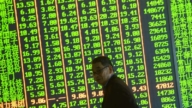【新唐人2014年05月31日訊】日前,中國十大銀行公布,截至去年底的逾期貸款達到5,880億元人民幣,創下2009年以來最高水平。那麼,這些貸款都給了誰?大量的不良貸款會給國家與民眾帶來甚麼後果?我們來看看。
據美國《彭博新聞社》報導,截至2013年底,中國十大銀行的逾期貸款達到5,880億元,同比大增21%,這是至少2009年來的最高水平。而且,銀行的「逾期貸款」比「不良貸款」高出31%,也創下5年來最大差距。
截至今年一季度末,商業銀行「不良貸款」餘額達6,461億元,較年初增加541億元,達到了過去3年以來的最高值。交通銀行預測,如果經濟明顯下滑,或者房地產價格危及相關行業,銀行壞賬率可能會升到2009年來的新高。這將給銀行帶來更多的損失,在中國經濟放緩的大背景下,借款人的日子將更難過。
美國金融分析、信用評級機構「標準普爾」認為,銀行的「逾期貸款」是資產質量惡化的領先指標。
中國金融智庫研究員鞏勝利:「幾大國有銀行佔了全國貨幣的80%以上,這個銀行一個出問題,就會牽涉到全國的經濟運行。」
大陸經濟學者鄧先生:「偷偷的變相的發貨幣(解決),比較嚴重的情景就是通脹和通縮同時發生。通貨緊縮,就是有錢也買不到貨,沒有人去生產,因為沒有資金,生產企業的資金周轉都非常困難﹔通貨膨脹的問題是甚麼,所有的東西價格太高買不起。」
90年代末,中共通過剝離四大國有銀行的不良貸款,成立了資產管理公司來處理這些爛帳,同時注資和斥資超過6,500億美元,對銀行實施了救助。
那麼這些錢到底去了哪裏?
鞏勝利:「首先貸給了國有企業,比如重慶的企業遇到了災難,國資委發動了所有的國有銀行,結果成交了300億,一下子就緩解了重慶的資金鏈的斷裂。非洲的援助項目比原先支付多了2/3。」
4月底,中國外匯管理局公布的數據顯示,「2013年中國對外投資」虧損599億美元,比上一年擴大了70%。
中國銀監會的數據顯示,中資銀行過去五年新增資產89萬億元人民幣,幾乎相當於美國銀行業的整體規模,而中國銀行業盈利佔了全球銀行業的30%,國務院發展研究中心研究員吳慶指出,中國的銀行躺著都能賺錢。
鞏勝利:「因為中國實行的很多政策都是雙軌制,人民銀行是發行貨幣的,但是人民銀行不經營貨幣,貨幣拿給了商業銀行來運行,那商業銀行運行的越多,它肯定獲得的利潤就越高,國家富了,老百姓依然貧窮,與銀行的利潤過高,有很大的關係。」
不過,根據中國「國泰君安證券」(Guotai Junan Securities)4月份的報告,中國16支上市銀行股的平均估值,為今年預估淨資產的0.77倍,由此反映的不良貸款率達到5.8%。在香港市場上,中國第一大銀行——工商銀行今年下挫5%,第二大的建設銀行下跌3%,第三大行農業銀行下挫9.7%。
中國金融智庫研究員鞏勝利指出,中國的國有銀行之所以能承受巨大的資金黑洞,除了政府的支持外,中國百姓,是它最大支柱。
交易所申報文件顯示,截至12月31號,招商銀行、浦發銀行、中信銀行、興業銀行和民生銀行,這些民營銀行的逾期貸款總額為1,330億元人民幣,比公布的不良債務高出77%。
鞏勝利:「五大商業銀行佔的貨幣總額超過了80%,這些壟斷性的銀行,它的市場這麼大,自然就賺了,小的銀行就沒有市場,沒有流動,更沒有辦法生存。比如說,中國工商銀行是全球的頭號了,沒有從全國老百姓那兒獲得的利益,它怎麼會長大呢。」
鞏勝利指出,國有銀行支持的國有企業,扼殺了中國的市場。
採訪編輯/劉惠 後製/舒燦
What Does an Overdue Loan of up to 600 billion RMB Mean to Chinese People?
In recent days, China´s 10 banks announced that at the end
of last year that overdue loans reached 588 billion RMB,
a record high since 2009.
So who received these loans?
How will a large amount of past due loans
impact the country and the people?
Let´s watch the program.
According to U.S. based Bloomberg News Agency,
at the end of 2013, the overdue loans of 10 Chinese banks
had reached 588 billion RMB, an increase of 21 percent
from last year and a new record since 2009.
In addition, the overdue loans are 31 percent higher
than bad loans, the largest gap in past five years.
The bad loans of commercial banks increased by 54.1 billion
during the first quarter of 2014, reaching 646.1 billion,
a record high over the past 3 years.
Bank of Communications forecasts that if the economy
significantly slows down or falling property prices
impact the relevant industries, the rate of bad accounts
will be the highest since 2009.
This will lead to more bank losses.
Given the slowing economy, lenders will suffer more.
Standard & Poor’s say the overdue loans are a guiding
precursor signifying the deterioration of assets.
China Financial Think Tank researcher Mr Gong Shengli:
“A few major state-owned banks own 80 percent
of the country´s monetary aggregates.
Once such banks have problems, the national economy
operation will be impacted.”
Mainland economic scholar Mr Deng:
“Secretly issuing currency is (to solve the issue).
But the relatively severe scenario is the concurrence
of inflation and deflation.
Deflation means that it is difficult to buy something
even with money in hand because there is no production
as a result of funds shortage and even the lack
of manufacturers´ revolving funds.
The issue with inflation is that prices are
so high they are unaffordable.”
At the end of the 1990s, the Chinese Communist Party (CCP)
disposed of the bad loans of four state-owned banks
via assets management companies that were specifically
developed for that purpose.
Meanwhile more than 650 Billion U.S. Dollars
were injected into them.
So where does such money go?
Gong Shengli: “First, the loans are lent
to state-owned enterprises.
For example, if enterprises in Chongqing meet with disaster,
the State-Owned Assets Supervision and Administration
Commission mobilize all state-owned banks
to provide funding.
As a result, these banks lent 30 billion RMB to relieve
the broken capital chain of Chongqing enterprises.
The aid funds to Africa are also two thirds
more than the scheduled funds.”
At the end of April, according to the data published
by China´s Foreign Currency Administration Bureau,
“2013 China´s Outbound Investment” lost 59.9 billion
U.S. Dollars, 70 percent more than this time last year.
According to China Bank Regulatory Commission data,
the increased assets of Chinese banks
over the past five years reached 89 trillion RMB,
equal to the assets scale of the entire U.S. bank industry.
Bank of China profits accounts for 30 percent
of the global bank industry.
Wu Qing, researcher at the State Development
Research Center, says Chinese banks can make money
even by doing nothing.
Gong Shengli: “Many Chinese policies
are binary systems.
Peopl´s Bank is only responsible for issuing currency
and they don´t do business with the currency.
All currency is operated by commercial banks.
So if the commercial banks have more money
to do business, then they surely obtain more profits.
The state can be richer, but the people are still poor.
Their poverty is related to the excessive profits of banks.”
However, according to China Guotai Junan Securities´
April report, the average valuation
of 16 publicly listed Chinese banks is 0.77 times
as much as the forecast net assets this year.
This shows that the bad loan ratio is 5.8 percent.
On the Hong Kong stock exchange, share prices
of the largest Chinese bank—Industrial and Commercial
Bank of China— are down 5 percent, while shares
of the second largest bank—Construction Bank of China—
fell by 3 percent and shares of the third largest bank—
Agriculture Bank of China—dropped 9.7 percent.
Gong Shengli commented that the reason
Chinese state-owned banks can sustain such a huge deficit
is mainly due to the support of Chinese people
and the government.
According to the declarations of the stock exchange,
up until Dec. 31, private banks, including China Merchants
Bank, Shanghai Pudong Development Bank,
China CITIC Bank, the National Commercial Bank
and China Minsheng Bank had overdue loans
of 133 billion RMB, 77 percent higher than their bad debts.
Gong Shengli: “The top five major commercial banks
have a total of currency amount of more than 80 percent
of all currency.
These monopolised banks have such a vast market
and it is natural to make money.
But small banks have no market and liquidity,
hence their survival is difficult.
For example, Industry and Commerce Bank of China
is the number one bank in the world.
How could it have grown so huge without having obtained
benefits from the people across China?”
Gong Shengli says the state-owned banks’ support of state-
owned enterprises also suffocates the Chinese market.
Interview & Edit/Liu Hui Post-Production/Shu Can



























